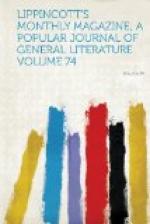One day during the latter part of my stay in Florence I went the second time to the splendid studio of Mr. Powers. He talked very eloquently upon art. He said that some of the classic statues had become famous, and deservedly so, although they were sometimes false in proportion and disposed in attitudes quite impossible in nature. He illustrated this by a fine plaster cast of the Venus of Milo, before which we were standing. He showed that the spinal cord in the neck could never, from the position of the head, have joined that of the body, that there was a radical fault in the termination of the spinal column, and that the navel was located falsely with respect to height. As he proceeded he convinced me that he was correct; and in defence of this, my most cherished idol after the Apollo Belvedere, I only asked the iconoclast whether these defects might not have been intentional, in order to make the statue appear more natural when looked at in its elevated position from below. I subsequently repeated Mr. Powers’s criticism of the Venus of Milo in the studio of another of our distinguished sculptors, and he treated it with great levity, especially when I told him my authority. There is a spirit of rivalry among sculptors which does not always manifest itself in that courteous and well-bred manner which distinguishes the medical faculty, for instance, in their dealings with each other. This courtesy is well illustrated by an anecdote I have recently heard. A gentleman fell down in a fit, and a physician entering saw a man kneeling over the patient and grasping him firmly by the throat; whereupon the physician exclaimed, “Why, sir, you are stopping the circulation in the jugular vein!” “Sir,” replied the other, “I am a doctor of medicine.” To which the first M.D. remarked, “Ah! I beg your pardon,” and stood by very composedly until the patient was comfortably dead.
While Mr. Powers was conversing with me about the Venus of Milo, there entered two Englishwomen dressed very richly in brocades and velvets. They seemed very anxious to see everything in the studio, talked in loud tones of the various objects of art, passed us, and occupied themselves for some time before the statue called California. I heard one of them say, “I wonder if there’s anybody ’ere that talks Hinglish?” and in the same breath she called out to Mr. Powers, “Come ’ere!” He was at work that day, and wore his studio costume. I was somewhat surprised to see him immediately obey the rude command, and the following conversation occurred:
“Do you speak Hinglish?”
“Yes, ma’am.”
“What is this statue?”
“It is called California, madam.”
“What has she got in ’er ’and?”
“Thorns, madam, in the hand held behind the back; in the other she presents the quartz containing the tempting metal.”
“Oh!”




